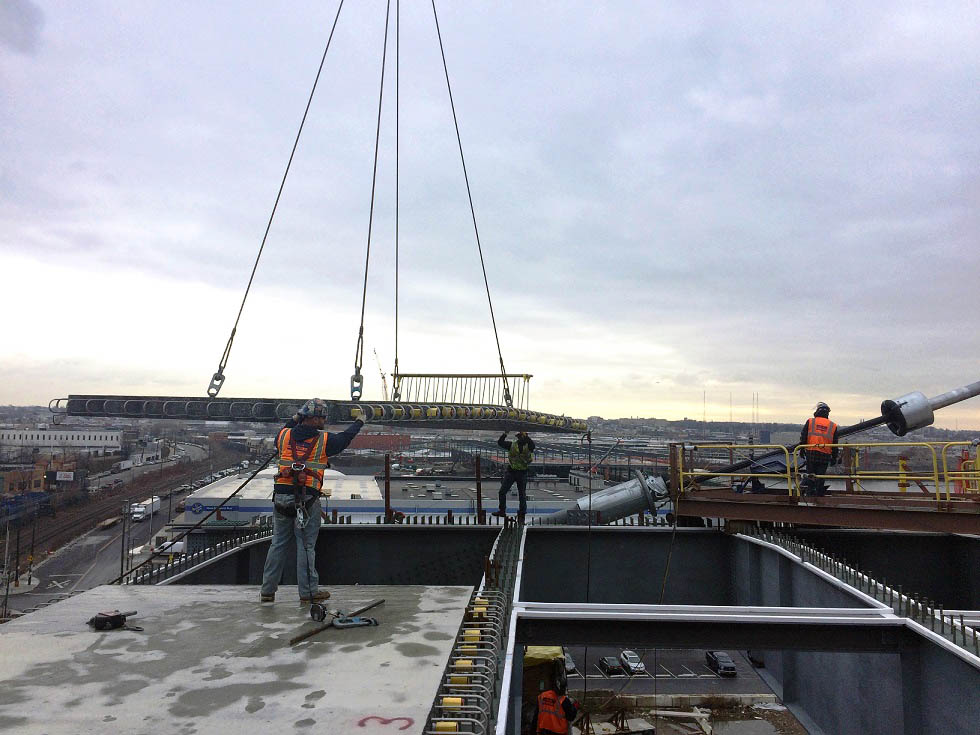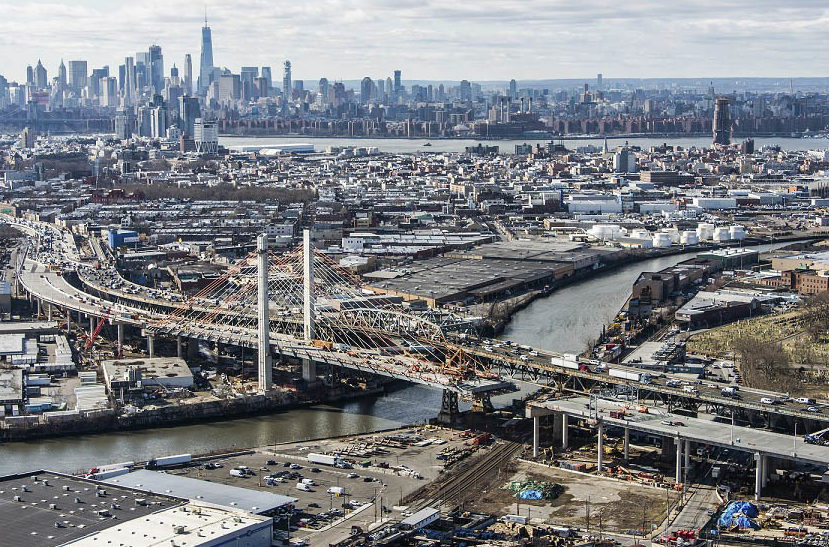Those of us Brooklyn drivers who routinely get stuck in traffic on the Kosciuszko Bridge were pleased to hear that the bridge would soon be demolished to make way for the new one. We can dream of progress toward a free-flowing Brooklyn-Queens Expressway. My own fantasy about the old bridge: to deploy a squadron of F-16 fighter jets to descend upon the rusting hulk and bombard it with air-to-air missiles, until all that was left was a pile of dust and satisfaction.
I am told by the New York State Department of Transportation that this will not be happening. At least not that way. Governor Andrew Cuomo announced last month that a controlled implosion will bring down the old, truss-style bridge in the “early summer” of this year. The governor plans to help push the plunger on the detonator, which he has enjoyed doing with other road projects.
At that point, BQE traffic will have shifted from the old bridge to the portion of the new structure being completed now. As the debris is being cleared, phase two of the project will begin: a sister bridge, which will create parallel roadways. One span will carry five Queens-bound lanes and the other span will carry four Brooklyn-bound lanes, a bike lane and a pedestrian walkway.
Goodbye to a Choke Point
The Kosciuszko Bridge was opened in 1939 and soon after named for Tadeusz Kosciuszko, a Polish general who served on the American side in the Revolution. (The bridge’s name is typically pronounced koss-ee-OSS-ko by locals, although ko-SHOOS-ko is closer to the Polish.) The bridge, connecting Greenpoint, Brooklyn, and Maspeth, Queens, over Newtown Creek, has long been a traffic nightmare. The three lanes in each direction, typically laced with potholes, weren’t designed to support the 180,000 motor vehicles that traverse the bridge each day.
The state decided in 2009 to replace it and in 2014 the Department of Transportation (DOT) awarded a design-and-build contract to a team led by Kansas City-based HNTB as the primary design firm and Skanska, the Swedish construction giant, as the managing partner. The contract, worth more than $550 million, is the largest single project ever awarded by DOT. “New York is recapturing the bold ambition that made this the Empire State in the first place, and accelerating construction of the new Kosciuszko Bridge is the latest example of how we are growing and innovating,” Governor Cuomo declared.

Construction workers lifting a section of the new bridge into place
Bringing It Down
Now back to the explosive part of the story. Andrew Herrmann, president of the Structural Engineers Institute, said that imploding the bridge has several advantages over disassembling it. “It is a very quick way of getting a structure down, especially if you are building something in the same place,” he said. “Once it’s down on the ground or the river or whatever you are going to catch it in, you can start building up above while they are taking the pieces away.”
The state is counting on that strategy to hurry up the process. Imploding the bridge, DOT officials, say, will save seven months vs. a more painstaking disassembly. Along with other project efficiencies, the fully functional new bridge is scheduled to be ready in 2020, four years ahead of the initial plan, the Governor’s office said.
The old bridge has three main sections that need to come down: the short, central span over Newtown Creek and the two long, elevated approach ramps. The central crossing will be disconnected from the rest of the bridge and lowered onto a barge with cranes, then hauled away. The two approaches, representing about ¾ of the length of the 1.1-mile bridge, will be demolished in a method that is technically not an implosion but “energetic felling,” according to DOT officials, which looks like this.
To set it in motion, relatively small explosives will be placed in key joint areas of the approaches and then detonated, allowing the structures to fall straight down. They will land on large berms of soil, which are designed to absorb noise and flying bridge parts. The disassembly and felling will be handled by the major contractors, who will likely delegate the explosive work to specialists. While the falling of the bridge sections may inspire many amateur videographers, anyone expecting a fireworks show will be disappointed, since most of the work is done by gravity rather than explosives.
Are Concerns Warranted?
Even when care is taken, energetic felling can have side effects, said Hermann. Shock waves can break nearby windows and the collision with the ground can kick up noise, dust and other pollution. DOT officials say they have held more than 140 meetings with experts and community members, called Stakeholder Advisory Meetings, to discuss the construction and demolition. The research indicated that energetic felling, besides being fast, is the safest and most environmentally friendly way to get the job done, said the DOT.
Local politicians have voiced concerns about the DOT putting speed ahead of safety. Brooklyn borough president Eric Adams said he found out about the decision to blow up the bridge the same way most of the public did: in the news media. In a press conference last month, Adams, along with members of Community Board 1 (representing Greenpoint and Williamsburg), said they wanted more information about the demolition’s environmental impact, especially considering that Newtown Creek is a Superfund site.

Neighborhood residents and politicians have voiced concern about the demolition, in part because of Newtown Creek’s status as a Superfund site
Cuomo’s office responded in a statement: “Implosion is the safest and the most efficient plan, so any theatrics or grandstanding from community leaders is not only unnecessary but entirely misleading.” The Governor’s staff has said they will keep the public abreast of the actual dates of said physics experiment.
The new, twin bridge, once completed, will be the only true cable-stayed bridge in New York City. (The Brooklyn Bridge is a hybrid of cable-stayed and suspension bridge.) The bridge reconstruction is part of Cuomo’s grand plan, the New York Crossings Project, to overhaul the city’s bridges, tunnels and other transportation. Tollbooths are being replaced with advanced sensor devices, bridges will be lit up by artful LED arrays, and tunnels will be fortified with floodgates. But if he could just unclog the BQE, he might even deserve to have it named after him.